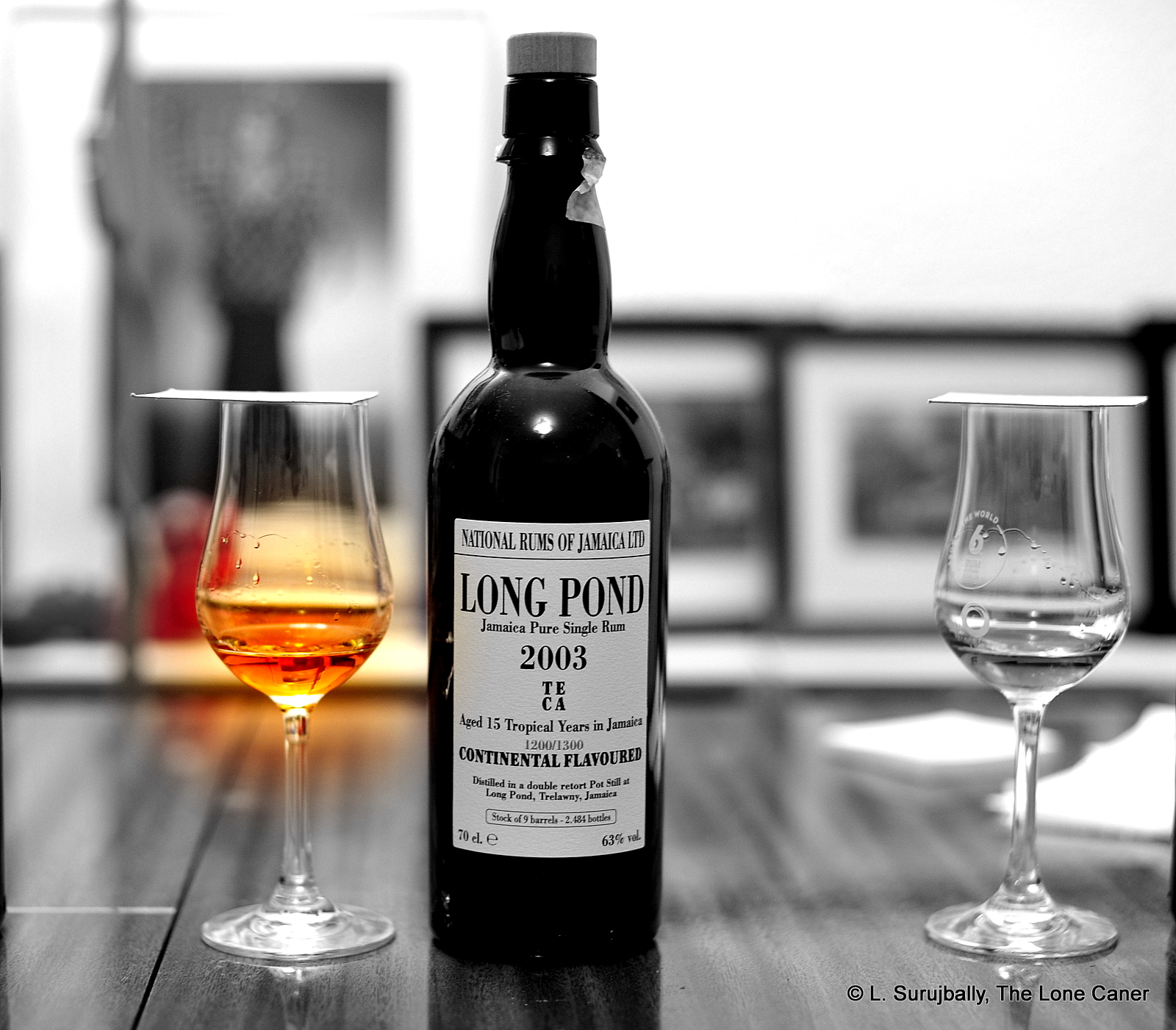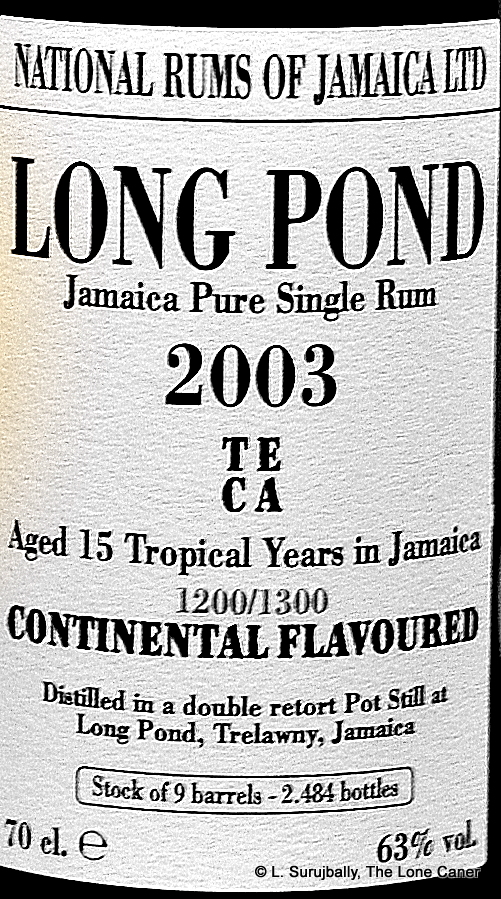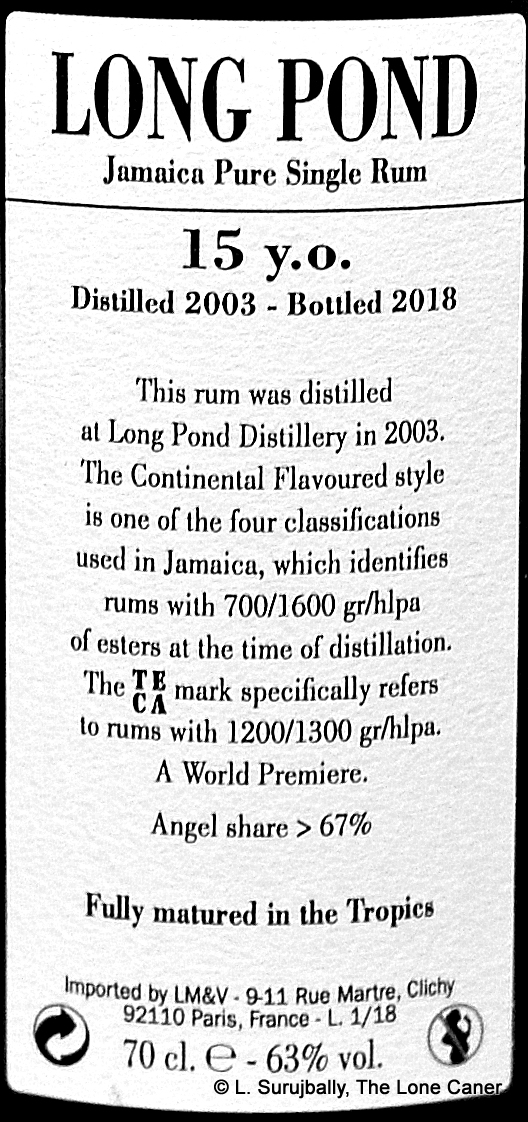
“Pungent f*cker, isn’t it?” smirked Gregers, responding to my own incredulous text to him, when I recovered my glottis from the floor where the TECA had deposited and then stomped it flat. Another comment I got was from P-O Côté after the Vale Royal review came out: “Can’t wait to read your thoughts about the TECA…!! … Hard to describe without sounding gross.” And Rumboom remarked on a taste of “sweat” and “organic waste” in their own rundown of the TECA, with another post elsewhere actually using the word “manure.”
I start with these varied comments to emphasize that I am not alone in believing that the TECA is a rum you hold in your trembling hands when surveying the reeking battlefield of the zombie apocalypse. I’m a fairly fit old fart of some mental fortitude, I’ve tasted rums from up and down the quality ladder…but the TECA still left me shell-shocked and shaking, and somewhere I could hear Luca sniggering happily and doing a fist pump. Partly or completely, this was because of the huge ester level the rum displayed -1200 gr/hlpaa (remember, 1600 is the maximum legal limit after which we enter “easily-weaponizable” territory), which the makers, staying within the traditional ester band names, refer to as “Continental Flavoured” but which I just call shattering.
 In sampling the initial nose of the third rum in the NRJ series, I am not kidding you when I say that I almost fell out of my chair in disbelief. The aroma was the single most rancid, hogo-laden ester bomb I’d ever experienced – I’ve tasted hundreds of rums in my time, but never anything remotely like this (except perhaps the Japanese Seven Seas rum, and I’d thought that one was a contaminated sample; now, I’m not so sure). All of the hinted-at off-the-wall aromas of the Cambridge were present here, except they were gleefully torqued up – a lot. It smelled like the aforementioned tannery gone amok or the hair salon dumping every chemical on the floor (at once) – it was a massive blurt of sulphur, methane, rubber and plastic dissolving in a bubbling pool of ammonia. It smelled like hemp rope and decomposing wet jute bags, joined by something really rancid – rotting meat, microwaved fish, and three-day-old roadkill marinating on a hot day next to the asphalt machine. There was the scent of a strong soy-flavoured vegetable soup and spoiling chicken tikka, raw onions and sweat. The clear, fruity ester background was so intense it made the eyes water and the nose pucker, cold and clear and precise, giving rather less enjoyment than a furious bitch slap of sharp pineapples, gooseberries, ginnips, unripe mangoes, salmiak, green apples. I know this sounds like a lot, but the rum’s nose went so far into uncharted territory that I really spent a long time on it, and this is what was there. And at the end, I really couldn’t say I enjoyed it – it was just too much, of everything. Hogo is what this kind of rotten meat flavour is called – or rancio or dunder or whatever — but for my money, it stands for “Ho God!!”
In sampling the initial nose of the third rum in the NRJ series, I am not kidding you when I say that I almost fell out of my chair in disbelief. The aroma was the single most rancid, hogo-laden ester bomb I’d ever experienced – I’ve tasted hundreds of rums in my time, but never anything remotely like this (except perhaps the Japanese Seven Seas rum, and I’d thought that one was a contaminated sample; now, I’m not so sure). All of the hinted-at off-the-wall aromas of the Cambridge were present here, except they were gleefully torqued up – a lot. It smelled like the aforementioned tannery gone amok or the hair salon dumping every chemical on the floor (at once) – it was a massive blurt of sulphur, methane, rubber and plastic dissolving in a bubbling pool of ammonia. It smelled like hemp rope and decomposing wet jute bags, joined by something really rancid – rotting meat, microwaved fish, and three-day-old roadkill marinating on a hot day next to the asphalt machine. There was the scent of a strong soy-flavoured vegetable soup and spoiling chicken tikka, raw onions and sweat. The clear, fruity ester background was so intense it made the eyes water and the nose pucker, cold and clear and precise, giving rather less enjoyment than a furious bitch slap of sharp pineapples, gooseberries, ginnips, unripe mangoes, salmiak, green apples. I know this sounds like a lot, but the rum’s nose went so far into uncharted territory that I really spent a long time on it, and this is what was there. And at the end, I really couldn’t say I enjoyed it – it was just too much, of everything. Hogo is what this kind of rotten meat flavour is called – or rancio or dunder or whatever — but for my money, it stands for “Ho God!!”
So that’s bad, right? Reading this, you’d think so. But courage, Sir Knight, hoist up thy codpiece and taste it. The very first expression in that section of my notes is a disbelieving “WTF?” … because it simply dumbfounded me – where did all the crazy-ass crap go? It tasted of soda pop – coke, or fanta – persimmons and passion fruits and red currants, sharp and tasty. Salt, brine, bags of olives, plastic, rubber, vanilla, licorice all rubbed shoulders in a melange made pleasant just by comparing it to the trauma of what went before. The rancio and spoiling meat hogo retreated so fast it’s like they just vapourized themselves. The flavours were powerful and intense, yes – at 62.5% ABV they could hardly be anything else – and you got much of the same fruitiness that lurked behind the funk of the smells, mangoes, tart gooseberries, red currants, unsweetened yoghurt and sour cream. But the real take away was that the nose and palate diverged so much. Aside from the sharp fruits and receding vegetable soup, there was also pistachio nuts, a sort of woodsy cologne, and even some over-sugared soda pop. And when I hit the finish line, it exhaled with a long sigh redolent of more pistachios, vanilla, anise, soy, olives and a veritable orchard of rotting fruits and banana skins.
The Long Pond TECA rum from National Rums of Jamaica is a grinning ode to excess of every kind. Given the profile I describe above (especially how it smelled) I think it took real courage for Luca to release it, and it once again demonstrates that he’s willing to forego initial sales to show us something we have not seen before, point us in a direction at odds with prevailing trends. It’s certainly unique – Luca remarked to me that it was probably the first time anyone had ever released such a high-ester well-aged Long Pond, and I agree. So far we’ve seen that the low-level-ester Vale Royal was a lovely, near-traditional Jamaican rum that edged gently away from more familiar island profiles, and the mid-level-ester Cambridge dared to step over the line and become something remarkably different, with strong tastes that almost redefined Jamaican and provided a taste profile that was breathtaking – if not entirely something I cared for. But the TECA didn’t edge towards the line, it didn’t step over it – it was a rum that blasted way beyond and became something that knocked me straight into next week. This was and will remain one of the most original, pungently unbelievable, divisive rums I’ve tried in my entire writing career, because, quite frankly, I believe it’s a rum which few outside the deep-dive rum-junkies of the Jamaican style will ever like. And love? Well, who knows. It may yet grow on me.
(#565)(79/100)
Background notes
(With the exception of the estate section, all remarks here are the same for the four reviews)
This series of essays on the four NRJ rums contains:
- NRJ Vale Royal 2006 12 YO VRW (11 barrels, 3412 bottles) 150/250 esters level
- NRJ Cambridge 2005 13 YO STC❤E (11 barrels, 3648 bottles) 550/700 esters level
- NRJ Long Pond 2003 15 YO TECA (9 barrels, 2484 bottles) 1200/1300 esters level
- NRJ Long Pond 2007 11 YO TECC (11 barrels, 3325 bottles), 1500/1700 esters level + summary
 In brief, these are all rums from Long Pond distillery, and represent distillates with varying levels of esters (I have elected to go in the direction of lowest ester count → highest, in these reviews). Much of the background has been covered already by two people: the Cocktail Wonk himself with his Jamaican estate profiles and related writings, and the first guy through the gate on the four rums, Flo Redbeard of Barrel Aged Thoughts, who has written extensively on them all (in German) in October 2018. As a bonus, note that a bunch of guys sampled and briefly reviewed all four on Rumboom (again, in German) the same week as my own reviews came out, for those who want some comparisons.
In brief, these are all rums from Long Pond distillery, and represent distillates with varying levels of esters (I have elected to go in the direction of lowest ester count → highest, in these reviews). Much of the background has been covered already by two people: the Cocktail Wonk himself with his Jamaican estate profiles and related writings, and the first guy through the gate on the four rums, Flo Redbeard of Barrel Aged Thoughts, who has written extensively on them all (in German) in October 2018. As a bonus, note that a bunch of guys sampled and briefly reviewed all four on Rumboom (again, in German) the same week as my own reviews came out, for those who want some comparisons.
The various Jamaican ester marks
These are definitions of ester counts, and while most rums issued in the last ten years make no mention of such statistics, it seems to be a coming thing based on its increasing visibility in marketing and labelling: right now most of this comes from Jamaica, but Reunion’s Savanna also has started mentioning it in its Grand Arôme line of rums. For those who are coming into this subject cold, esters are the chemical compounds responsible for much of a given rum’s flowery and fruity flavours – they are measured in grams per hectoliter of pure alcohol, a hectoliter being 100 liters; a light Cuban style rum can have as little as 20 g/hlpa while an ester gorilla like the DOK can go right up to the legal max of 1600 at which point it’s no longer much of a drinker’s rum, but a flavouring agent for lesser rums. (For good background reading, check out the Wonk’s work on Jamaican funk, here).
Back in the day, the British classified Jamaican rums into four major styles, and many estates took this a few steps further by subdividing the major categories even more:
Standard Classification
- Common Clean 50-150 gr/hlpa
- Plummer 150-200 gr/hlpa
- Wedderburn 200-300 gr/hlpa
- Continental Flavoured 700-1600 gr/hlpa
Exactly who came up with the naming nomenclature, or what those names mean, is something of a historian’s dilemma, and what they call the juice between 301 to 699 gr/hlpa is not noted, but if anyone knows more, drop me a line and I’ll add the info. Note in particular that these counts reflect the esters after distillation but before ageing, so a chemical test might find a differing value if checked after many years’ rest in a barrel.
Long Pond itself sliced and diced and came up with their own ester subdivisions, and the inference seems to be that the initials probably refer to distilleries and estates acquired over the decades, if not centuries. It would also appear that the ester counts on the four bottles do indeed reflect Long Pond’s system, not the standard notation (tables.
RV 0-20
CQV 20-50
LRM 50-90
ITP /LSO 90-120
HJC / LIB 120-150
IRW / VRW 150-250
HHH / OCLP 250-400
LPS 400-550
STC❤E 550-700
TECA 1200-1300
TECB 1300-1400
TECC 1500-1600
The Estate Name:
It’s unclear whether the TECA stands for Tilston Estate, one of the estates that got subsumed into Long Pond in the wave of consolidations in the 1940s and 1950s (this is the theory to which Luca subscribes), or for Trelawny Estates, the umbrella company created in the 1950s before being taken over by the Government and renamed National Rums of Jamaica. This is where some additional research is needed – nobody has written (so far) on the meaning of the “CA”, though given the Long Pond marks listed above, it’s reasonable to suppose it’s Tilston/Trelawny Estate, Continental Type A (as opposed to “B” or “C” with progressively higher ester levels. The various histories of Long Pond written by Barrel Aged Thoughts, the Cocktail Wonk and DuRhum provide useful background reading, though they do not settle the mark designation issue conclusively one way or the other.
Note: National Rums of Jamaica is not an estate or a distillery in and of itself, but is an umbrella company owned by three organizations: the Jamaican Government, Maison Ferrand of France (who got their stake in 2017 when they bought WIRD in Barbados, the original holder of the share Ferrand now hold) and Guyana’s DDL.
After 35 years of drinking everything under the sun,( BAR METHO!:) – and particularly Rum, Whisky and Cognac/Brandy in greater quantity in more recent years ,I can unequivocally say that the Long Pond (Velier) 2003 15 years old TECA is the best spirit I have consumed to this point. With all due respect, I may not have as refined a palate as an expert, but letting it breathe in a large Lead/crystal Snifter for 30 mins may be a prerequisite for getting the best out of this Run.Any way, I found this Rum (taken neat) to be vvery palatable, aurally delightful, and all this “hogo” and ” funk” nonsense is a lot of marketing mumbo-jumbo! For goodness sake ,it is only distilled sugar cane. Of course the ageing, barrels and distillation will impact the final result, but this is absolutely RUM in it’s purest form and any thing else is a bastardisation.
Completely agree with your review. What struck me immediately was the characteristic Jamaican profile mixed with sulfur and tar. To be honest, it smells and tastes exactly like Iceland. Go to Blue Lagoon or Ion Adventure Hotel: the smell is identical.